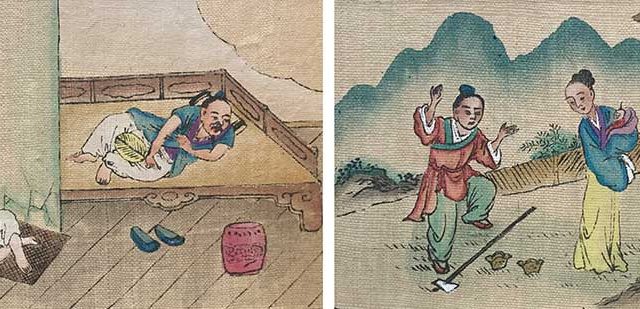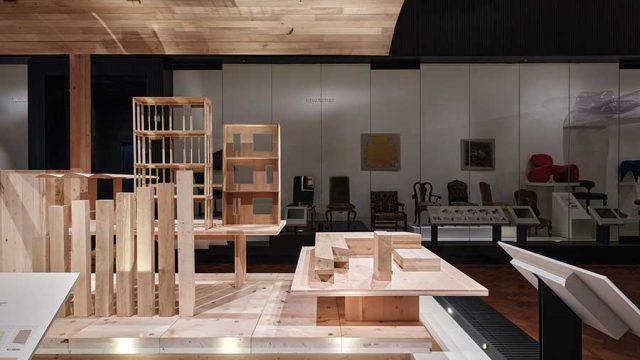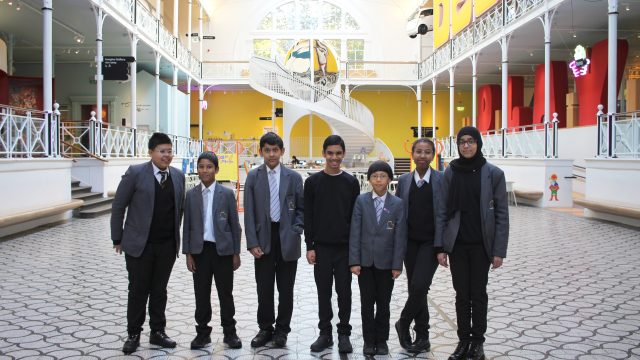Ranti Bam is a British-Nigerian artist whose work in ceramics made a big impression on the V&A East team last year when we came across several of her sculptural vessels on display at the annual art fair Collect. We were lucky enough to secure one piece, Itari, for the V&A’s collection. One year on – a year in which ‘real life’ encounters with artworks and indeed, other people, have been rare – Ranti and I discuss her creative practice and how acts of making can be powerful sources of connection, solace and joy.
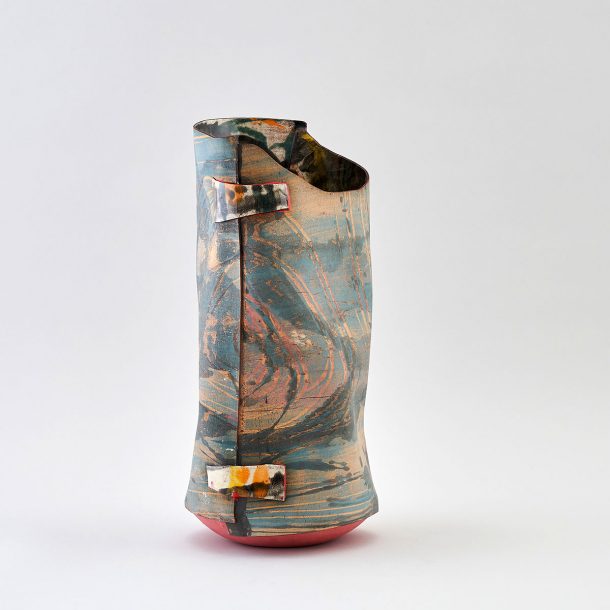
Ranti, you’re currently in residence at the Cite Internationale des arts in Paris where last year you set up a regular ceramics workshop with Franco-African women in the Goutte d’Or neighbourhood. Can you tell me a little bit about how these workshops came about? What was the intention behind them, and what role does connecting with other people play in your practice?
Having observed that my vessels function as ‘hearths’, objects around which an audience gathers in contemplation, meditation and discourse, I began holding workshops with the intention of sparking the wonderful conversations that happen around art. And because making art creates a space of non-judgment, these workshops become more than a space for participants to learn clay-making skills, they become platforms that harness the curative properties of clay to nurture a spirit of creativity, imagination, reflection and connection to themselves and their environment. They facilitate open, meaningful dialogue.
The first workshop I held was a few years ago at a contemporary art space in Lagos, Nigeria. At the end of it a young man came to tell me that as a result of the weekend workshop, he felt closer to his father, a sculptor he had never met. Since then, I have held workshops including in the UK in London for architects, Kenya for feminist activists and recently in France to hold conversations about postcolonialism. So, I am merely a conduit who loves this extraordinary material, believes in its magical powers and wants to share them with the world.
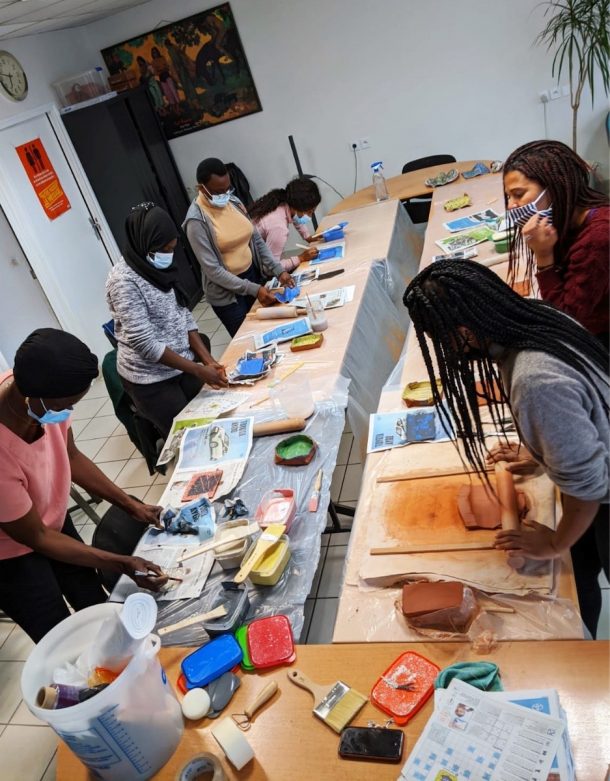
I’m really interested in this notion of the curative properties of clay, particularly in this current moment as the pandemic rages on! As part of our gallery development for V&A East we’ve been looking at a variety of works in the collection for which the act of making itself has played a healing or cathartic role, whether for an individual or for a group of people brought together in the process. Opportunities for making as a means for meditation and reflection feel more important than ever right now. But the virus must have been taking hold just as you began your residency, so how did you manage to reconcile your plans to bring people together in this way with the disruption of the health crisis? Was the curative role brought into sharper focus?
I was able to hold the workshops as I envisaged, however due to COVID rules and regulations the numbers were kept low and we wore masks. Though this did not diminish the quality of the workshop. On the contrary, I think not seeing my mouth meant that more attention was on my hands.
The curative is always going to be needed. To be human means there will be a desire for a degree of solace at most points in our life. I acknowledge that the need for healing in the context of this crisis is more pronounced and immediate, however the connection, openness and solidarity the workshops create, is always going to be pertinent.
What is the significance of using clay in this space and in your practice? What was it that drew you to clay as a material and to the process of making ceramics in the first place?
I felt a synergy with clay right from the first moment I touched it. After school, I forgot all about the material until my MA where I used it conceptually to manifest my hypothesis, which was ‘How can art help man understand his inseparability from his environment’ aka a dialogue between the known and the experienced. After my MA I knew I wanted to delve further into the material technically, and so I signed up for a 2-year Ceramics Degree course at City Lit where all my tutors were renowned.
The haptic is important to me, as is a holistic experience of the world. I am very aware of my body in space, and dextrous with my hands, and so I enjoy the corporeal immediacy of working with clay. With this material there is a symbiosis. There is so much I love about it – the way it registers and remembers every action. It feels to me as if I am working with air itself manifested as matter. I also enjoy that it is a material that can do and be anything you want. I like that it has great narrative potential, also revealing truths about its creator as well as stories about civilisations long gone. I love the poetry of all the elements, earth, wind, water, fire and air, combining into one form. I find it constantly reinforces in me patience and acceptance.
When my team and I came across your vessels at Collect last year there was something very immediate and visceral about the experience of them. Their haptic qualities really drew us in. But there was also a real joyousness – in their fluid forms, colour and texture, with the sense of freedom exercised in their creation palpable. They are constructed through a process of wrapping adorned slabs together, rather than built up from the bottom. With Itari – the piece we were lucky enough to secure for the collection – the use of tabs, as if fastening these elements, along with its monoprinted surface, means the clay is almost reminiscent of cloth. I particularly enjoy the subversive use of glaze on the interior, as if somehow the form has been pulled inside out. Everything works together to produce something that feels strong and resolute, yet at the same time vulnerable. Is this something you aim for? How do you make decisions around colour, form, texture?
I’m glad you speak about joyousness. For me my work is a celebration of life. A celebration of my life, and wonderful experiences I have moving through the everyday. A celebration of clay and its materiality and extraordinary ability. And a celebration of people I meet in the spaces that my work leads to.
For my last series, the inspiration were abstract paintings I had made during the first lockdown when I did not yet have access to clay but instead to tubes of acrylics courtesy of a fellow resident. Often the beginning of a work is inspired by a line in a book I’m reading or a quote from an article that moves me. In and out of my workshop, I am devoted to words.
So, I approach the clay with an idea in mind and then I just let things unfold organically and intuitively from there. I work fast and it seems to me that I am problem solving. Always trying to redress something in the whole of the piece so that it all just sits and fits just right.
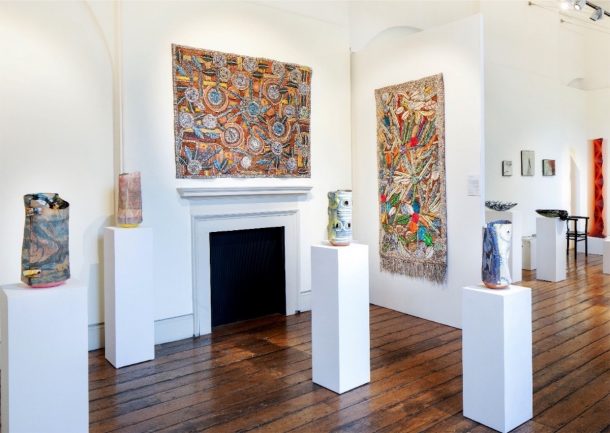
With part of the V&A East project being a new Collection and Research Centre – a new open-access store for our thousands of objects – we’ve been interested in how the V&A’s holdings are used by makers across all disciplines as a source of inspiration. Opportunities to see aspects of our collection through the eyes of those that make and create is something we plan to offer our future audiences. You’ve mentioned to me in the past that the V&A is one of your favourite spaces – is this a place you’ve found inspiration? Do you have a go-to gallery or favourite object?
The V&A was vital to me during my Ceramics Diploma course. I knew I wanted to work with clay, I had great narrative ambitions, but I truly had not seen enough ceramic art to know what the material’s real potentialities were. And so, the V&A’s Ceramics department, 4th floor, was a most wonderful source of inspiration.
I am just as inspired by texture, textiles and the material as I am by words, and I work with clay like it’s fabric – cutting, stitching, constructing, assembling. Visiting the V&A’s costume and textile collection always provides me with ideas. I am also inspired by those who have a mastery of their medium. Alexander McQueen was one such person for me. I saw the Savage Beauty exhibition at the V&A and I was extremely moved. It was one of the most spectacular shows I have seen.
That’s great to hear Ranti. We so look forward to welcoming you back to the museum once the lockdown is lifted, and to the V&A East sites once they are open! I’d like to round off by asking what’s next for you and your practice?
Upcoming projects include mixed media sculptural pieces under the theme Rock, Paper, Scissors, some collaborative work and eventually setting up my own studio.
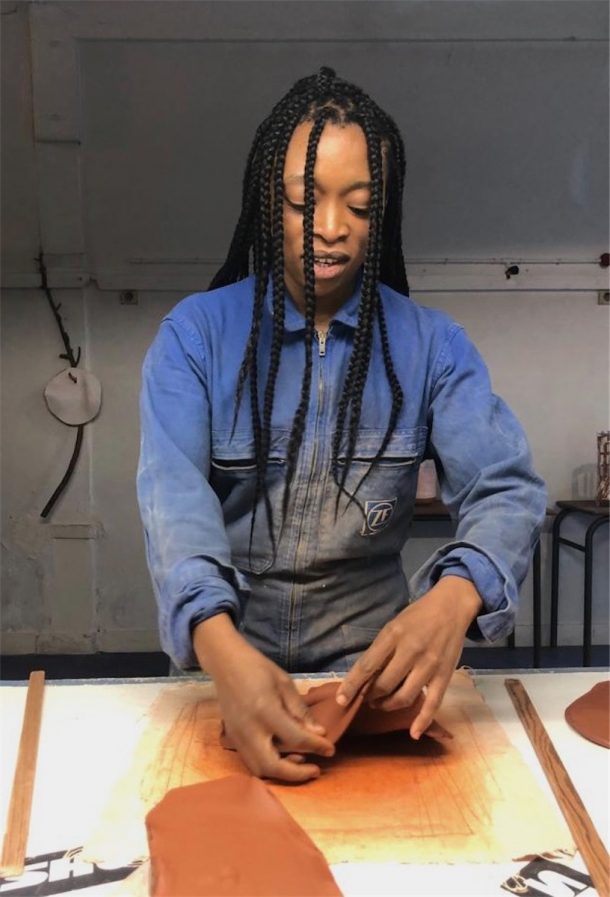
To see further works by Ranti Bam visit www.50golborneart.com/ranti-bam
